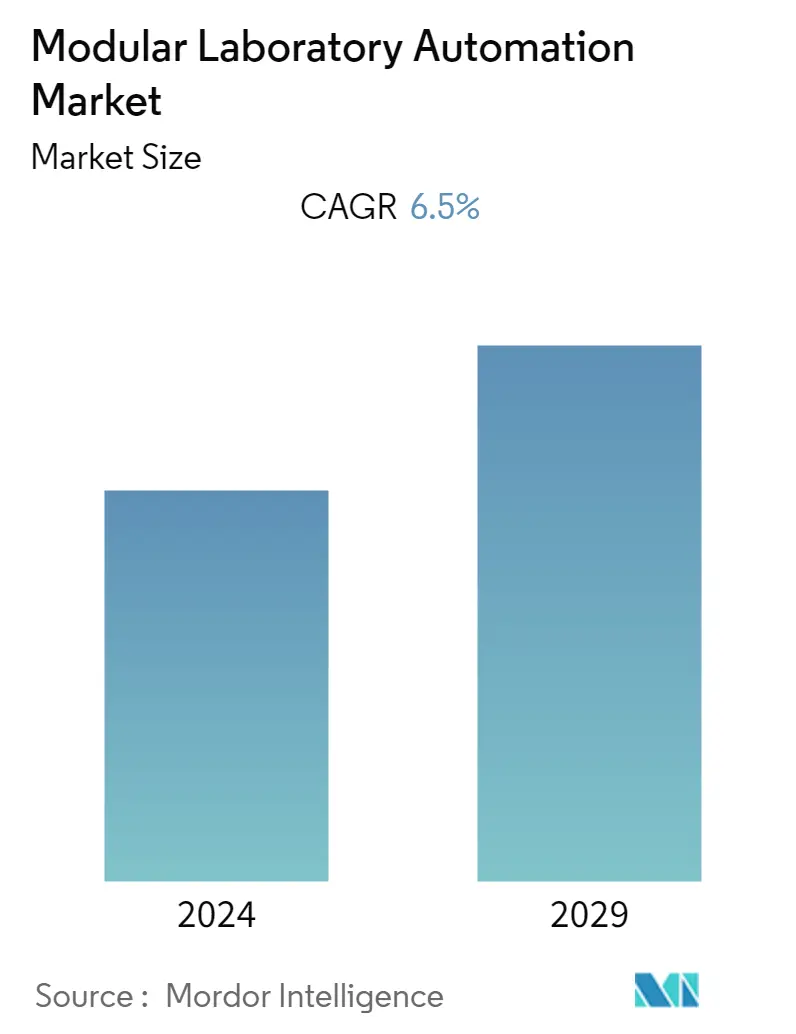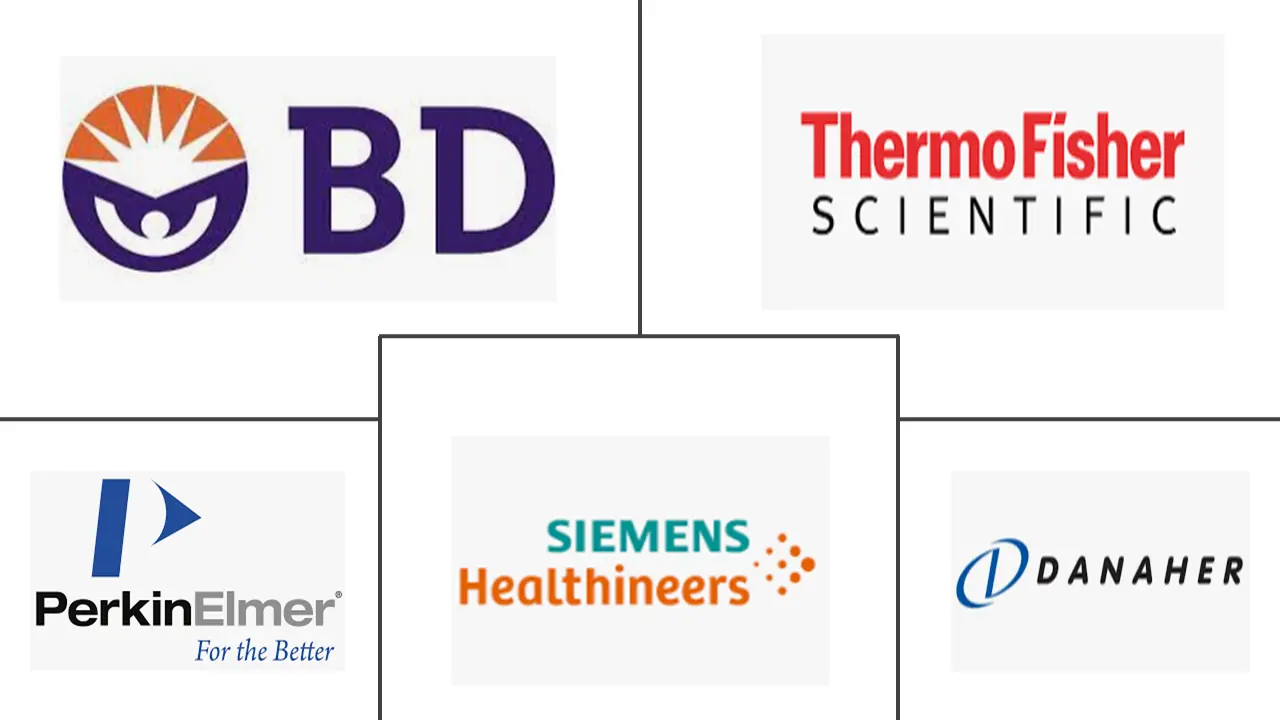Market Size of Modular Laboratory Automation Industry

| Study Period | 2019 - 2029 |
| Base Year For Estimation | 2023 |
| CAGR | 6.50 % |
| Fastest Growing Market | Asia Pacific |
| Largest Market | North America |
| Market Concentration | Low |
Major Players
*Disclaimer: Major Players sorted in no particular order |
Modular Laboratory Automation Market Analysis
The modular laboratory automation market is anticipated to grow at a CAGR of 6.5% over the forecast period. Laboratory automation has transformed the medical laboratory space by steadily replacing semi-automatic and manual methods with fully automated systems. These automation systems are beneficial in sterile environments, wherein human error is significantly reduced and time is saved. Routine laboratory processes, such as testing, screening, etc., are automated. Automation tools can process concurrent requests in real time, showing marked improvement in productivity and throughput.
- One of the primary reasons expected to promote market expansion shortly is the rise in benefits given by lab automation. A paradigm change from total manual intervention to lab automation has various advantages for clinical laboratories. Reliable outcomes, safe working conditions, higher productivity, and significant time, space, and cost savings are just a few of the primary benefits. Lab automation makes it easier to utilize laboratory equipment for repetitive processes like sample verification and tube labeling and lowering and limiting the physical strain caused by manual chores, which saves money and space in the lab.
- Emerging markets are likely to provide considerable growth possibilities for lab automation product manufacturers and distributors during the projected period. Increasing demand for clinical diagnostic processes, resulting in increasing lab automation equipment sales. Major product manufacturers are expanding their distribution networks and production capabilities in new areas to increase their market share. This presents a profitable potential for laboratory automation.
- Liquid handlers and robotic arms are gradually becoming handy for performing different tasks with increased efficiency in modular laboratory environments. Conversely, the automation tools also handle the demand for the systematic execution of specific tasks, like running ELISA assays.
- In recent years, molecular diagnostic assays have relied significantly on real-time PCR technology, which detects the amplification of DNA in real-time, while PCR is in progress using a fluorescent reporter. More than 75% of clinic molecular diagnostic tests are amenable to real-time PCR procedures. This technology has provoked a new molecular biology market by offering rapid assays for better diagnosis and personalized treatment of complex diseases.
- Further, the use of laboratory automation tools in early cancer detection and increased adoption in microbiology have been the major contributors to the market growth in North America and Europe. MLA (Medical Laboratory Assistants) tools are widely employed for diagnosis in emerging markets like India and China, and the demand for these tools is expected to rise steadily.
- The COVID-19 pandemic has accelerated medicine development and research while putting additional strain on clinical laboratories and pharmaceutical companies. As a consequence of the increased interest in microplate readers, automated liquid handling, and robots, ensuring a shorter TAT has become a priority. On the other hand, the epidemic has resulted in lower revenues and margins for hospitals and health systems, as well as lower expenditures on automation and technology. As a result, the long-term market for modular laboratory automation is impacted.
Modular Laboratory Automation Industry Segmentation
Laboratory automation is defined as any device, software, or process that requires minimal human intervention and improves the efficiency of the laboratory. Laboratory automation includes the use of robots, machines, conveyors, software, vision, etc. Various equipment and software, depending upon the application, can be used in modular laboratory automation. The Modular Laboratory Automation Market is Segmented by Equipment and Software (Automated Liquid Handlers, Automated Plate Handlers, Robotic Arms, ASRS, Software, Analyzers), Field of Application (Drug Discovery, Genomics, Proteomics, Clinical Diagnostics), and Geography.
| By Equipment and Software | |
| Automated Liquid Handlers | |
| Automated Plate Handlers | |
| Robotic Arms | |
| Automated Storage and Retrieval Systems (ASRS) | |
| Software | |
| Analyzers |
| By Field of Application | |
| Drug Discovery | |
| Genomics | |
| Proteomics | |
| Clinical Diagnostics | |
| Other Fields of Application |
| By Geography | ||||||
| ||||||
| ||||||
| ||||||
| Rest of the World |
Modular Laboratory Automation Market Size Summary
The modular laboratory automation market is poised for significant growth, driven by the transition from manual to automated systems in medical laboratories. This shift enhances productivity and reduces human error, particularly in sterile environments. Automation tools streamline routine processes such as testing and screening, offering benefits like reliable outcomes, safe working conditions, and substantial savings in time, space, and costs. The market is further bolstered by the increasing demand for clinical diagnostics, with emerging markets presenting lucrative opportunities for manufacturers and distributors. The adoption of advanced technologies, such as liquid handlers and robotic arms, is enhancing efficiency in modular laboratory settings, while real-time PCR technology is revolutionizing molecular diagnostics, facilitating rapid assays for complex disease diagnosis and personalized treatment.
The Asia-Pacific region is expected to witness heightened demand for lab automation solutions, fueled by the burgeoning pharmaceuticals market and increased investment in research and development. The region's favorable conditions for pharmaceutical research, including a diverse population and cost-effective skilled labor, make it an attractive hub for outsourcing drug development. The modular laboratory automation market is characterized by fragmentation, with numerous companies entering the space, driven by the rapid growth in clinical and pre-clinical studies. Key players like Thermo Fisher Scientific, Danaher Corporation, and Becton Dickinson are leading innovations, while strategic collaborations and investments are further propelling market expansion. The COVID-19 pandemic has accelerated the adoption of automation technologies, highlighting the need for efficient testing solutions and optimizing productivity in laboratory settings.
Modular Laboratory Automation Market Size - Table of Contents
-
1. MARKET INSIGHTS
-
1.1 Market Overview
-
1.2 Industry Value Chain Analysis
-
1.3 Industry Attractiveness - Porter's Five Forces Analysis
-
1.3.1 Bargaining Power of Suppliers
-
1.3.2 Bargaining Power of Buyers
-
1.3.3 Threat of New Entrants
-
1.3.4 Threat of Substitute Products
-
1.3.5 Intensity of Competitive Rivalry
-
-
1.4 Assessment of COVID-19 Impact on the Industry
-
-
2. MARKET SEGMENTATION
-
2.1 By Equipment and Software
-
2.1.1 Automated Liquid Handlers
-
2.1.2 Automated Plate Handlers
-
2.1.3 Robotic Arms
-
2.1.4 Automated Storage and Retrieval Systems (ASRS)
-
2.1.5 Software
-
2.1.6 Analyzers
-
-
2.2 By Field of Application
-
2.2.1 Drug Discovery
-
2.2.2 Genomics
-
2.2.3 Proteomics
-
2.2.4 Clinical Diagnostics
-
2.2.5 Other Fields of Application
-
-
2.3 By Geography
-
2.3.1 North America
-
2.3.1.1 United States
-
2.3.1.2 Canada
-
-
2.3.2 Europe
-
2.3.2.1 United Kingdom
-
2.3.2.2 Germany
-
2.3.2.3 Spain
-
2.3.2.4 Rest of Europe
-
-
2.3.3 Asia Pacific
-
2.3.3.1 China
-
2.3.3.2 Japan
-
2.3.3.3 South Korea
-
2.3.3.4 Rest of Asia Pacific
-
-
2.3.4 Rest of the World
-
-
Modular Laboratory Automation Market Size FAQs
What is the current Modular Laboratory Automation Market size?
The Modular Laboratory Automation Market is projected to register a CAGR of 6.5% during the forecast period (2024-2029)
Who are the key players in Modular Laboratory Automation Market?
Thermo Fisher Scientific, Danaher Corporation, Becton Dickinson, Siemens Healthcare and PerkinElmer are the major companies operating in the Modular Laboratory Automation Market.

